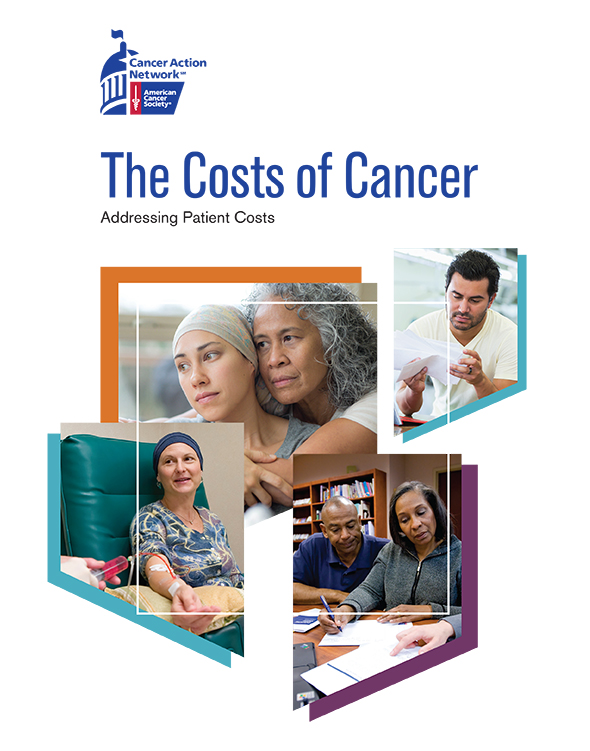 Download Report - Costs of Cancer
Download Report - Costs of Cancer
Cancer is one of the leading causes of death and disease in the U.S. The American Cancer Society (ACS) estimates that roughly 1.7 million new cases of cancer will be diagnosed in the U.S. in 2017[i] and more than 15 million Americans living today have a cancer history.[ii] Not only does cancer take an enormous toll on the health of patients and survivors – it also has a tremendous financial impact.
For patients and their families, the costs associated with direct cancer care are staggering. In 2014 cancer patients paid nearly $4 billion out-of-pocket for cancer treatments.[iii] Cancer also represents a significant proportion of total U.S. health care spending. Roughly $87.8 billion was spent in 2014 in the U.S. on cancer-related health care.[iv] These costs were paid by employers, insurance companies, and taxpayer-funded public programs like Medicare and Medicaid, as well as by cancer patients and their families.
The American Cancer Society Cancer Action Network (ACS CAN), the nonprofit, nonpartisan advocacy affiliate of the American Cancer Society, supports evidence-based policy and legislative solutions designed to eliminate cancer as a major health problem. This ACS CAN report focuses specifically on the costs of cancer borne by patients in active treatment as well as survivors. It examines the factors contributing to the cost of cancer care, the type of direct costs patients pay, and the indirect costs associated with cancer. To more fully illustrate what cancer patients actually pay for care the report also presents scenario models for three types of cancer - lung, breast, and colorectal; in three types of insurance coverage – employer-sponsored insurance, an individual market plan, and Medicare.
Key Report Findings
- Access to quality health insurance is essential to making cancer care affordable for patients and survivors.
- A lower premium insurance plan may not actually save cancer patients money. Such plans often have high-cost sharing and cancer patients are high utilizers of care.
- Even with insurance, cancer patients often face unpredictable or unmanageable costs including high co-insurance, high deductibles, having to seek out-of-network care, and needing a treatment that is not covered by their plan.
- Newly diagnosed cancer patients often experience their highest out-of-pocket costs in the first one to two months following a positive screening or diagnosis until they meet their applicable deductible and out-of-pocket maximums.
- In each of the cancer scenarios included in the report the patient with employer-sponsored insurance paid the least in premiums and cost-sharing and the patient with individual market insurance paid the most.
- Limits on out-of-pocket costs significantly lowered patients’ expenses in two of the three insurance scenarios. Without these limits, patients’ costs would have sky-rocketed.
- The profiles illustrate that without insurance coverage, cancer patients would likely face treatment costs totaling tens and possibly hundreds of thousands of dollars.
- Passing public policies that prevent cancer and its costs to patients and society by reducing tobacco use and exposure to secondhand smoke, promoting healthy eating and active living, and protecting Americans from increased skin cancer risk associated with exposure to UV radiation emitted by indoor tanning devices.
- State and federal policymakers can address cancer patients’ costs by:
- Ensuring cancer patients, survivors and those at risk for cancer have access to health insurance that is adequate, available, affordable and easy to understand.
- Providing all Americans access to no cost prevention and early detection services – preventing cancer and diagnosing it earlier can reduce patient costs.
- Passing public policies that prevent cancer and its costs to patients and society by reducing tobacco use and exposure to secondhand smoke, promoting healthy eating and active living, and protecting Americans from increased skin cancer risk associated with exposure to UV radiation emitted by indoor tanning devices.
Download Data Slides (PDF)
[i] American Cancer Society. Cancer Facts & Figures 2017. Atlanta: American Cancer Society, 2017.
[iii] Agency for Health Care Research and Quality. Total Expenses and Percent Distribution for Selected Conditions by Source of Payment: United States, 2014. Medical Expenditure Panel Survey Household Component Data. Generated interactively. (December 13, 2016)
